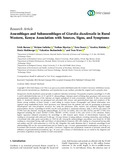| dc.description.abstract | Background. Giardia duodenalis causes sporadic or epidemic infections in humans. The parasite comprises assemblages A-H with A and B subdivided further into AI-IV and BI-IV subassemblages. Attempts aimed at linking these genotypes with sources and gastrointestinal manifestations of the infection are largely unexplored in rural communities. Methods. In this cross-sectional study, G. duodenalis infection was genotyped and associated with sources, and gastrointestinal signs and symptoms of the disease among residents of Busia County, a rural setting in western Kenya. Demographic and clinical information were captured using standardized forms. Stool specimens were obtained from the patients and used for genotyping at glutamate dehydrogenase and triose-phosphate isomerase loci using the polymerase chain reaction and restriction fragment length polymorphism. Results. Assemblage B (63.6%) was the most prevalent G. duodenalis infection, while A (20.5%) and mixed A/B (15.9%) were also detected. Among the subassemblages, AI (5.7%), AII (8.0%), AIII (3.4), BIII (30.7%), and BIV (17.0%) were diagnosed including the mixed AII/BIII (15.9%), BIII/BIV (15.9%), AI/AIII (2.3%), and AI/AII (1.1%) infections. Binary logistic regression indicated associations for assemblage A with stomach upset, history of nitroimidazole treatment, and residing in a homestead with cattle and B with years, history of eating outdoors, vomiting, steatorrhea, and residing in a homestead with cattle, goats, and poultry ( for all). Among the subassemblages, associations were found for AI with residing in a homestead having cattle and history of nitroimidazole treatment, BIII with residing in a homestead having cattle and poultry, and BIV with steatorrhea ( for all). Altogether, this study illustrates that G. duodenalis assemblage B and subassemblage BIII are the most predominant and are linked to years, gastrointestinal manifestations, and living in a homestead with domestic ruminants and poultry. Conclusion. Targeted mass prophylactic treatment of domestic animals and utilization of gastrointestinal presentations, years, and a history of nitroimidazole use are useful in the diagnosis and prevention of giardiasis among residents of rural communities. | en_US |
| dc.subject | Assemblages, Subassemblages,Giardia, duodenalis , Rural, Western, Kenya, Association, Sources, Signs, and Symptoms | en_US |

